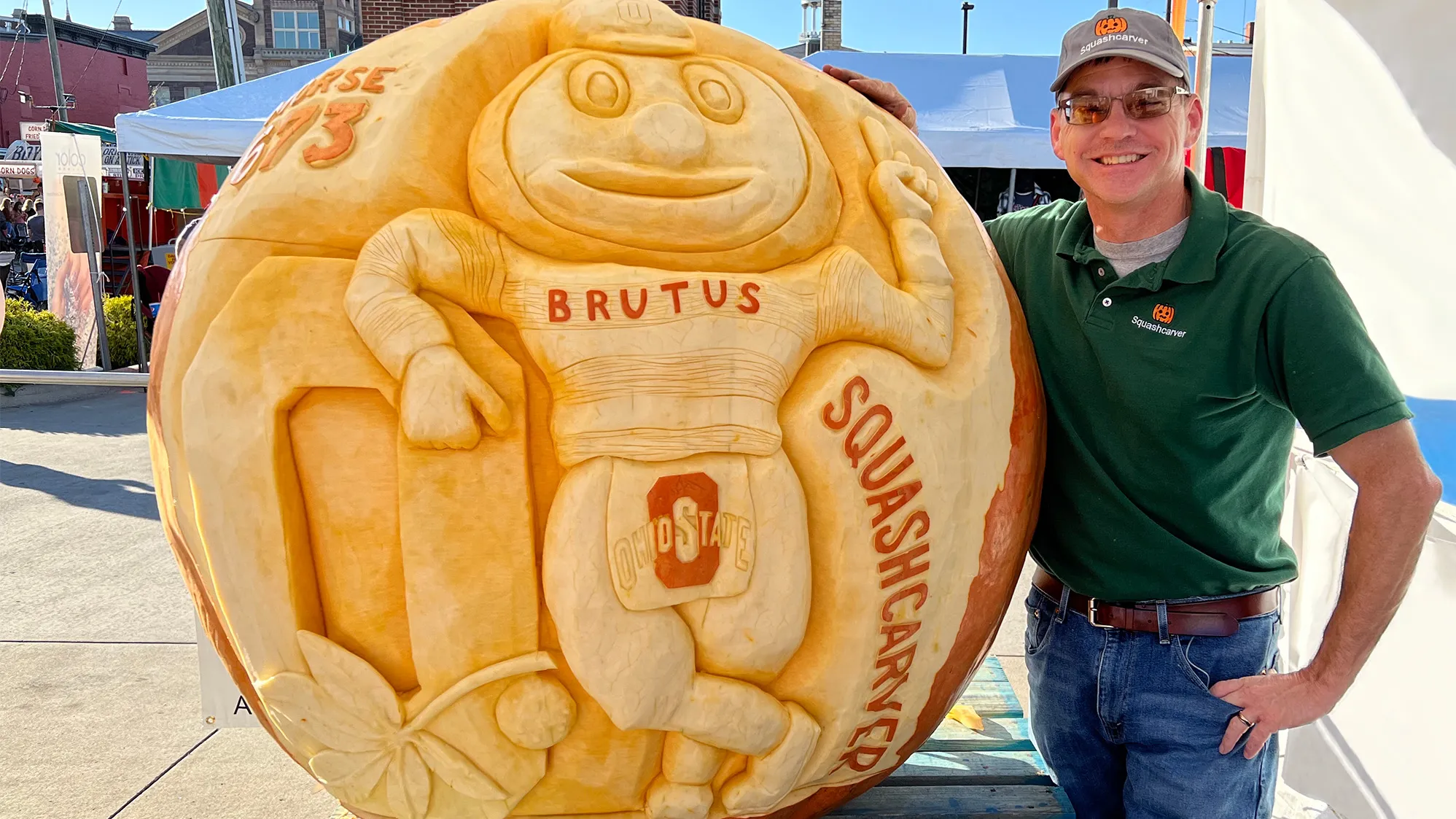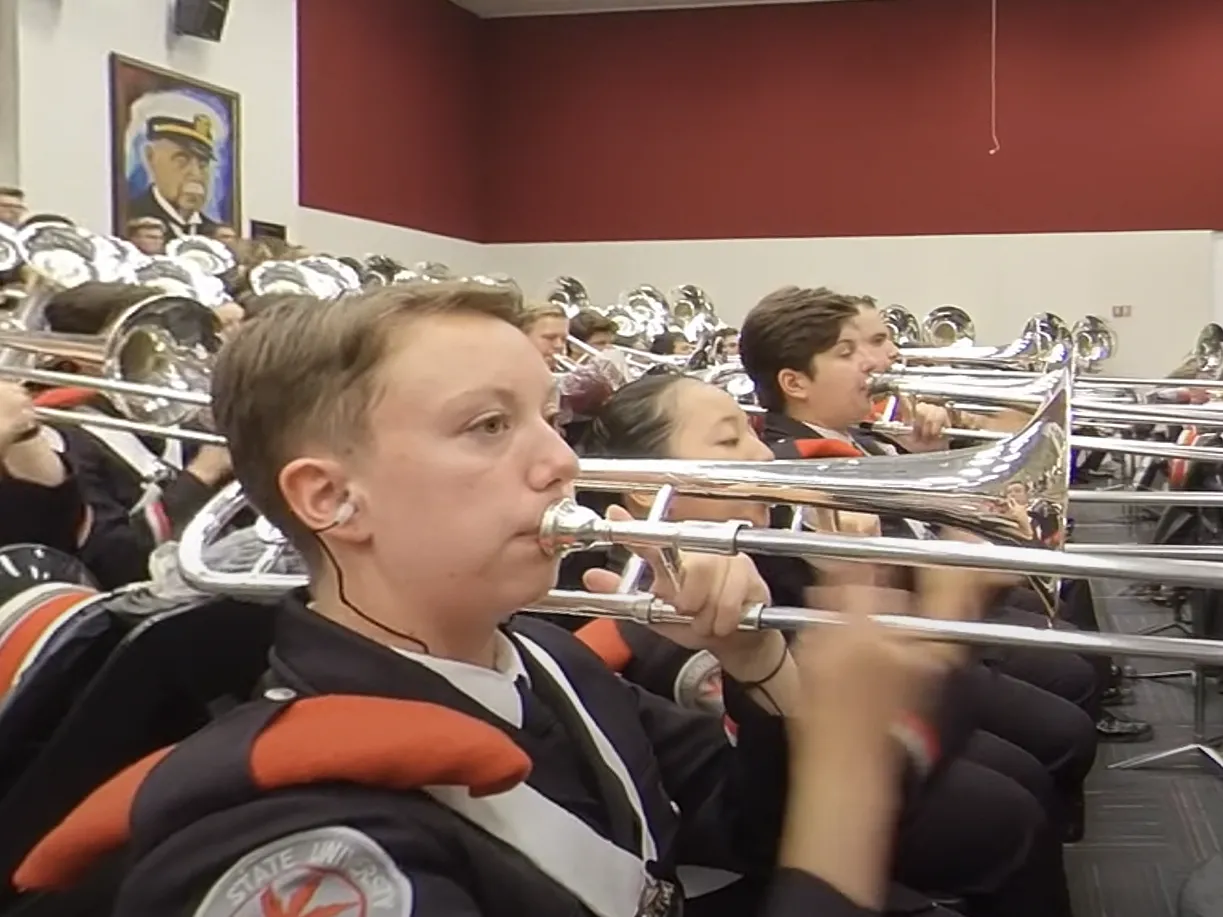
How Gus Smithhisler became a pro pumpkin carver
In the above video, Gus “Squashcarver” Smithhisler shares what it’s like to be a professional pumpkin carver, while offering words of wisdom and inspiration. Runtime is 1 minute, 43 seconds.
How does one go about becoming a professional pumpkin carver? For Gus “Squashcarver” Smithhisler ’90, ’94, it started with growing giant pumpkins. That itself is a feat, with each plant requiring about a hundred gallons of water per day. “For giant pumpkins, it’s just a matter of how much they weigh,” Smithhisler says. “It doesn’t matter how pretty they are.”
A few years into it, in August 2001, he was at the Indiana State Fair for a weigh-in and harvesting the seeds from his misshapen giant. These pumpkins are a special variety, so growers save the seeds instead of buying new ones for the next year. “I have my giant knife. I’m cutting out the seeds, and I’m like, ‘These are pumpkins. Why doesn’t someone carve them?’” Go ahead, his fellow growers said. So he did.
“Someone comes up asking how long I’ve been carving. I said, ‘About an hour.’ They said, ‘No, I mean professionally.’” He laughs when he recounts it because his answer didn’t change. “About an hour.”
Smithhisler free-handed the fair logo. While he had taken just a single art class during his years at Ohio State—he majored in civil engineering—he’s always been someone who draws. He had carved the occasional Halloween jack-o-lantern, but he had no special experience or interest in sculpting squashes.
The next year at the same event, he connected with a man the fair had paid to fly from the West Coast to carve pumpkins live. That man shared tips, and Squashcarver the business was born. The next year, the fair paid Smithhisler to carve. It turned out to be a niche that needed filling, and people loved watching him turn pumpkins into art while narrating. He would soon be hired by places like the Columbus Zoo and Aquarium and the Bellagio casino in Las Vegas. At this time (and for 32 years), Smithhisler worked full-time for the Ohio Department of Natural Resources. He would eventually get so many carving requests, he’d have to take off a month every fall.
Smithhisler has carved a few pumpkins bigger than 2,000 pounds; those designs included an octopus and a bear catching a fish. But he no longer grows giant pumpkins—just followings. Social media has been a boon for Squashcarver. Smithhisler’s wife, Holly Van Tilburg Smithhisler ’05, majored in nursing at Ohio State, but she’s become an expert at platforms that help the couple market.
She makes fun videos of Gus carving and posts to many platforms—TikTok and YouTube are their biggest, but they also do Instagram and Facebook. So they reach all generations. The result? Business from brands including Disney, Tim Hortons, Starbucks and the cash app Afterpay. How’d Holly learn? By developing a smart habit: “I’d read or watch Youtube videos every day,” she says, “so I can go deeper into learning the tech side. Every day. Don’t stop.”
With Gus’s charisma and performance art and Holly’s know-how, the couple are making their business thrive. The demand is to the point, they can’t accept every opportunity that comes their way, even though Gus has retired from ODNR and now focuses on the business.
“I love doing this, and it’s turned into a business that I can make money at,” he says. “I tell kids all the time, if you like to dance, but you want to go to school to be an engineer, that’s fine. Be an engineer—but still dance if you want to. If you ride horses but you want to go be a lawyer, go be a lawyer. Go get your education, but still ride horses. You never know when the next opportunity will come up.”
3 tips for small-business owners from Holly Smithhisler
- You must have a webpage and a Facebook business page. They’re just non-negotiables these days. “That’s how people find you,” she says. Your website doesn’t need to be complicated, but it needs to show off what you do well and clearly help people contact you.
- If you’re posting pictures or videos to social media or online, make sure to put your name on them. If they’re good, inevitably, others will pick them up (legally or not) and help market your business for you.
- Related to that, make sure you’re putting alt text on your photos, to describe them for those with visual impairments, but also so search engines can find them easier. Always make sure to put your business name in that text, too.
Need some Buckeye stencils?
The Ohio State University Alumni Association is sharing Buckeye-themed pumpkin stencils that include Brutus, Script Ohio and a buckeye leaf. Follow this link to request the downloadable files.

